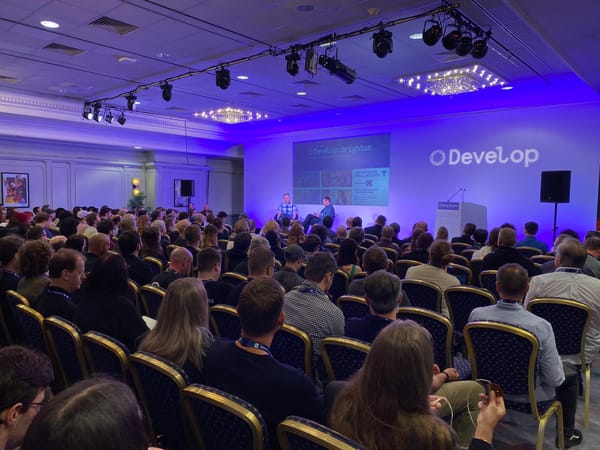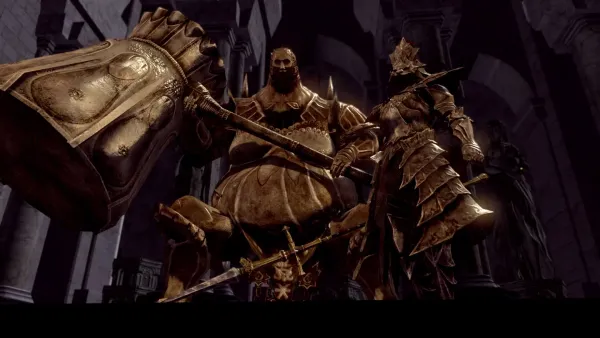#123: Unlikely story
Inafune and Improbable trundle into the elephant's graveyard in the metaverse.
As a magazine editor, I like to think I employed a light touch when it came to other people’s work. It was about turning the already very good into great, subtly tweaking dials like a sound engineer at a live gig, or the producer behind the mixing desk in an album session. And god knows as a writer I’d seen enough of my work hacked to bits by an over-eager subs desk. I knew how it felt and was not inclined to inflict it on my staff and freelancers. Fourteen thousand years ago, shortly after I became Edge’s games editor, the mag’s production editor was given a rare opportunity to write for the mag. I was, in hindsight, a little intrusive with the edit. On the day the review was published on the now-defunct Edge website, the writer took me to one side, quietly furious. “The only nice thing anyone has to say about my review,” he muttered, “is a line you bloody wrote.” It was a hell of a line, in fairness, but lesson learned.
I certainly knew better than to mess with a writer’s final line, because I know how precious writers are about it: I myself am the most precious of all in that regard. But on one occasion I simply couldn’t resist. I asked the reviewer of Mighty No. 9, the expensively crowdfunded, much-delayed, colossally hyped and really not very good game from Mega Man creator Keiji Inafune, if I could make a little tweak to his conclusion. He consented, so I got to publish this:

Lovely.
I was reminded of that this morning because Keiji Inafune is back, in the 2022 equivalent of Pog form. That’s right: he’s only bloody gone and done NFTs! Well, maybe, anyway. There is speculation that this is just the latest in the ever-lengthening line of scam NFT projects, that is using Inafune’s name as a way of drumming up buzz. Inafune himself is yet to comment, though as the project hasn’t been officially announced, you wouldn’t expect him to just yet. So, who knows. But it seems plausible enough, does it not? This is becoming a bit of a theme: forgotten former superstars sensing one final payday, and turning to the buzzwords du jour for one last grasp at the nettle of fame. If Inafune is indeed involved in this, he would merely be following an increasingly well-trodden path down which the likes of Peter Molyneux and Will Wright have already walked. He is highly unlikely to be the last.
I do not blame them, really: there are clearly pots of money to be made from this stuff regardless of whether an endeavour succeeds or fails. As far as I can tell we are living in an era where a game developer can barely finish saying the word ‘metaverse’ before the VCs across the table fling term sheets at them. There are no bad ideas in this space at the moment. Sure, there don’t appear to be many good ones either, but the venture-capital community is, for the time being, happy flinging shit at the wall to see if anything sticks, confident that before long a unicorn will come along to make the whole endeavour worthwhile.
This is not just about high-profile individuals, either. Yesterday it emerged that Improbable, maker of the once-much-fancied cloud-computing platform SpatialOS, has sold off Midwinter Entertainment, maker of Scavengers and the final remnant of Improbable’s short-lived internal development initiative. Improbable is now going all Metaversey instead.
Throughout its years in business, Improbable has been excellent at marketing — ‘10,000 players at once!’ is an irresistible hook — and even better at fundraising: the $500m it got from Softbank in 2017 was at the time the biggest tech investment the UK had ever seen. But its core tech wasn’t up to snuff, at least for videogames. Last year, in a Financial Times report on Improbable’s struggles, DayZ creator Dean Hall said: “The technology wasn’t scaling. It was expensive to host on the cloud, performance, and bandwidth heavy.” Another developer reckoned that the cost of keeping servers online in their game after launch would cost $5 per user every month.
Partner developers began pulling out, the handful of SpatialOS games that had launched closed down, and eventually Improbable arrived at the obvious conclusion: SpatialOS just wasn’t working out. Earlier this year it sold Inflexion to Tencent, and has now offloaded Midwinter to Behaviour Interactive. It has successfully diversified a little over the years, its contracts with the UK and US governments for military-training simulations bringing in, according to the FT, around £25m in two years. But that’s not enough to keep the lights on at a company that has raised almost a billion dollars in its ten years in business.
So, it is little surprise that Improbable is doing Metaverse stuff now. Last month it unveiled M2, a spun-off entity dedicated to Metathings, backed by $150m of funding from web3 shit-flinger-in-chief Andreesen Horowitz. Now, there is perhaps a certain logic to this. SpatialOS may have been ill-suited to videogames, where constant, complex calculations proved too much for Improbable’s cloud servers to handle, particularly once concurrent-user numbers spun up into the thousands. But this Metastuff is probably a little less demanding, no? Standards certainly seem to be a little lower. This is, after all, the sort of thing that Metaverse people are getting excited about:
So, yes, I get it. A pretty low bar to clear, and piles of money to be made.
But! M2’s headline attraction is Otherside, a frightfully — and suspiciously, cynics might say — ambitious large-scale MMO-ish thing being made in partnership with Yuga Labs, the outfit behind Bored Ape Yacht Club. For those of you whose eyeballs are yet to roll clean out of their sockets, here’s the sales pitch from the game’s official website:
“You got here just in time.
Otherside is a gamified, interoperable metaverse currently under development. The game blends mechanics from massively multiplayer online role playing games (MMORPGs) and web3-enabled virtual worlds. Think of it as a metaRPG where the players own the world, your NFTs can become playable characters, and thousands can play together in real time.”
Yegods. Let’s have a look at the suspiciously singleplayer tech demo:
Yegods.
The blockchain-gaming revolution, if ever it should come — and on current evidence it looks less likely by the day — will not arrive courtesy of Improbable, or Inafune or Molyneux. History suggests that the breakout game, or experience or whatever, will be made by someone you have ever heard of. No one knew of Zynga before Facebook, or Supercell before mobile, and I suspect the same will apply here. I do not begrudge these development legends, or these ailing companies, for making these moves. Secure the bag, and all that. But with each new such addition to the ranks, this increasingly cluttered space feels more and more like an elephant’s graveyard. The longer the trend continues, so progressively worsens the stench.
(Now that’s a final line.)
MAILBAG!
Loads of you got in touch in response to Monday’s edition, on the trouble with esports for spectators. I am overwhelmed. A nice problem to have, but apologies to the dozen or so of you I can’t fit in here.
- “Esports does have an accessibility problem that it's never quite solved,” writes Jessica. “However, it's a bit like the Grand National — you'll watch it even though you know nothing about horses because of the occasion. Most will watch it, see who wins, and switch it off again. But there'll be a small minority that get hooked on the rivalries, the legacy of the horses and their jockeys, and the sheer excitement that they'll start watching racing more regularly. By tuning in more frequently, they'll learn how form works, how racing on different grounds might affect the outcome, and more. Esports is exactly like that — it gets its claws into you and you learn that way.” I can see the argument here, and it roughly tracks with my time watching Street Fighter, but I don’t think the Grand National comparison quite holds up. As I said on Monday, the aim of most traditional sports is pretty clear: in this case, the horses are jumping over big hedges and hoping not to die. I’ve watched a bit of Dota in my time and I’m still not entirely sure what the goal is. That initial barrier of complexity is (insert horse-racing analogy here).
- “For esports, and especially shooters, what the scene needs is cameramen,” David offers. “Free-flying viewpoints operated by a few people (not the commentators) to provide most of the footage for the feeds, using player viewpoints to replay specific notable plays. Basketball or any other sport would be very baffling to try to watch if it was recorded entirely in firstperson.” This is true, and a pal tried to implement something similar a few years back in a game with esports aspirations. I think you’d lose a little impact, a little drama — a headshot is obviously much more exciting viewed in firstperson than from up in the rafters — but it’s worth experimenting with for sure.
- “There are some benefits to esports,” Jon says. “I'm a primary-school teacher and have started doing an esports club at my school. When I announced it in assembly, there was a sea of blank faces, until I said the word 'videogames' and many little pairs of eyes lit up. There has been a lot of research into the benefits of esports in terms of team building, researching and problem solving, planning for future careers and learning about digital citizenship. I'm working very hard to make sure we're not just a club where we just play videogames, but we also research the skills and tools needed to improve, the training required and the marketing required to boost our teams. There is also an organisation, the British Esports Federation, which is a nonprofit set up to help schools and colleges with their initiatives. It is early days, but I have already found out I am in no way as good as any of the children at Mario Kart.”
Thanks to everyone who wrote in; I am greatly enjoying the discussion around this stuff. Feel free to get into it with each other in the comments, or just hit reply to shout at me directly.
MORE!
- Speaking of Andreesen Horowitz, they’ve just announced a new $600m games fund. Feels like they’re a bit behind the curve on this one, but never mind. In the announcement blurb the VC firm praises games for “pioneering best-in-class mechanisms for user engagement, retention, and monetisation, such as microtransactions, battle passes, and web3 tokens” so, yes, right in the sea.
- Saudi Arabia’s Public Investment Fund has acquired a 5% stake in… Nintendo? Ah, shit. It is now the fifth largest shareholder in the company.
- More fallout from Jim Ryan’s reproductive-rights gaffe last week. Insomniac boss Ted Price told staff that Sony would not approve any statements from PlayStation Studios teams on the Supreme Court’s proposed overturning of Roe vs Wade. Insomniac has donated $50,000 to the Women’s Reproductive Rights Assistance Project, which Sony will match through its PlayStation Cares initiative. However, it appears the scheme applies to charitable donations of any kind — so if a Sony studio or employee donated to a pro-choice organisation, the company would match that too.
- Sony’s acquisition of Bungie isn’t expected to close until later this year, which gives the Destiny studio a few more months to nail its colours to the mast. It’s spoken out against the Buffalo shooting, is donating merch revenue to the Southern Poverty Law Centre, and has pledged to root out extremism in its online communities. CEO Pete Parsons says his studio will never be muzzled on these issues — an early test for Sony’s stated intent to let Bungie run independently after the acquisition completes.
- Grand Theft Auto V has passed 165 million lifetime sales. Several of those — I’ve honestly lost count — were by me.
There we go! I must now put this hastily to bed so I can do an interview for Max HP, Hit Points’ all-too-occasional subscriber-exclusive, longform interview series. I realise I’ve been a bit lax with these, and have Bold And Ambitious Plans for the near future. Onwards!
Oh hey, today is Hit Points’ first anniversary. While I didn’t unveil it to the world until early June, May 18th was the day I first started tooling around with the idea in secret (though a couple of pals came on board after a week or so to help finesse the thing). Happy first birthday to Hit Points! Perhaps you’d give the thing a share by way of celebration. See you Friday.





